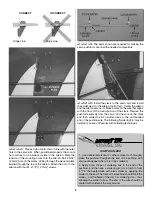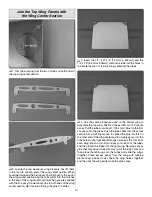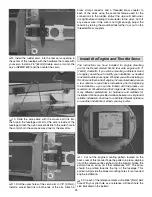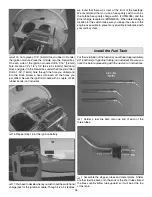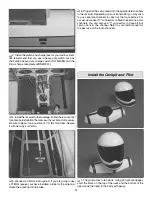
21
❏ ❏
4. Install the servo into the fuselage with the servo
spline oriented towards the front of the fuselage. Secure the
servo with the hardware that came with the servo. Place a
nylon control horn in line with the servo arm. When positioned
properly the control horn will rest on a hardwood plate in the
elevator. Mark the location of the mounting holes onto the
elevator. Drill a 3/32" [2.4mm] hole on the marks, drilling
through the plywood plate
but not
through the top of the
elevator. Attach the horn to the elevator with four #4 x 1/2"
[12.7mm] screws.
❏
5. Repeat steps 1-4 for the remaining elevator servo.
4-40 THREADED
COUPLER
BRASS CRIMP
CONNECTOR
❏
6. Locate the spool of .038 [.96mm] wire and cut it in
half. Slide a brass crimp connector onto one end of the wire
followed by the threaded brass connector and then feed the
wire back through the crimp connector. Squeeze the crimp
connector fi rmly onto the wire to secure the threaded coupler
to the wire. Thread a 4-40 nut onto the coupler followed by
the nylon swivel ball link. Do this for both pieces of wire.
❏
7. Two of the large black control horns need to be
modifi ed in order to get full rudder defl ection. Using a Dremel
tool, modeling knife or other cutting tool, shape the control
horn to match the one shown. Drill the outer hole to 1/8"
[3.2mm] diameter.
❏
8. Position a control horn in line with the rudder pull-pull
wire exit hole on the side of the fuselage and on the plywood
plate located in the rudder. Mark the location of the four
mounting holes for the control horn. On each of the marks
drill a 1/8" [3.2mm] hole through the plywood plate, drilling
completely through the rudder. Attach a control horn on each
side of the rudder using four 4-40 x 3/4" [19.1mm] machine
screws and four 4-40 nuts. Be sure you use thread locker on
each of the nuts.


